The Yogas of Jyotish
One of the most intriguing and valuable features of Jyotish is it’s vast canon of ‘Yogas’ and associated aphorisms. The word ‘yoga’ essentially means to ‘join’ or ‘unite’, and here can be translated as an astrological combination or ‘union of factors’ with specific implications. The Yogas of Jyotish are the fruit of centuries of observation, codified into a rich body of lore regarding the effects of several hundreds of possible permutations of the heavens.
Some are simple, and yet useful, and their purported meaning would be unsurprising and even familiar to a western astrologer, due to all the DNA shared by western and vedic astrology. Others are a lot more complex, and may involve linking or synthesizing factors in the chart that a superficial analysis would easily overlook. These yogas are therefore a type of analytical tool, or a means to inculcate certain analytical habits that can reveal the presence of notable patterns in a chart.
Of course all yogas are not of equal significance and import, and even when the criteria for a given yoga are met in a chart, there is further refinement in analysis for the astrologer to undertake in the consideration of the finer specifics of the chart in hand. These will modify the strength, texture and specific zones of influence of the yoga.
Apart from the obvious utility of having various special indications in a chart ‘cononized’ and memorized, through studying the yogas the more general rules and principles of Jyotish are further elucidated for the student. Clues are given regarding how the more basic rules of Jyotish can be more expertly used in chart interpretation and chart synthesis, beyond the strict confines of the formalized yogas.
Before looking at a few of the more widely known and useful yogas of Indian astrology, a few preliminary technical considerations.
What I’m presenting here is intended for application to charts calculated according to the ‘Jyotish astronomical settings’, using the sign and house measurements conventional to that system.
If you are a western astrologer or student you are probably using the Tropical Zodiac and Placidus Houses, and beyond using Uranus, Neptune and Pluto, you probably consider a number of other more recently discovered astronomical bodies also.
For the purposes of working with these ancient Yogas of Jyotish let’s for the time being keep to the 9 planet paradiagm of Jyotish: the 7 planets the days of the week are named after, and the two Nodes, Rahu and Ketu.
To calculate the sign and house placements of the planets from the Jyotish perspective, you need to use the Sidereal Zodiac (select the Lahiri Ayanamsha on your software if you don’t have a specific preference), and Whole Sign Houses. (1)
With Whole Sign Houses the 1st House covers precisely the expanse of the entire Ascending sign, the whole of the following sign will be the 2nd House, and any planets occupying that sign will be in that sign will be in the 2nd House, the whole of the following sign will constitute the 3rd House, and so on.
In the case study diagrams that follow, the diagram on the left shows the chart using conventional western Tropical/Placidus settings, and on the right you will find the Sidereal/Whole Sign chart.
The Pancha Mahapurusha Yogas
‘Pancha’ means five, ‘Maha’ means ‘great’, ‘Purusha’ means ‘person’ or ‘being’. So, the Pancha Maha Purusha Yogas are ‘five combinations that produce a great being’.
These yogas are formed when Mars, Mercury, Jupiter, Venus or Saturn (the ancient planets excluding the luminaries and nodes) are located in their own or exaltation signs, while also being in a ‘Kendra’ (or angular house- 1st, 4th, 7th & 10th).
That’s the usual definition. Light on Life, by Hart de Fouw and Robert Svoboda (2) states that these yogas are also formed when these planets are in their own or exaltation signs, while being in the ‘Kona’ or ‘Dharma’ houses (1st, 5th & 9th).
The italicized interpretations quoted below for the Mahapurusha Yogas are from an ancient Jyotish text named Phaladipika (3), as presented in Light on Life.
Ruchaka Yoga is the Mahapurusha Yoga of Mars, formed when Mars is in Aries, Scorpio or Capricorn, while also in an angular house.
“The person born in Ruchaka Yoga will have a long face, will acquire wealth by doing many daring deeds, will be brave, will overcome his enemies, and will be powerful and arrogant. He will become renowned for his merits, will be a leader of an army, and will emerge victorious in all his attempts.”
Adolf Hitler and Muhammed Ali both have Mars in Sidereal Aries; Hitler in the 7th and Muhammed Ali in the 10th. Both were in different ways ‘professional warriors’ who were also arguably ‘powerful and arrogant’.
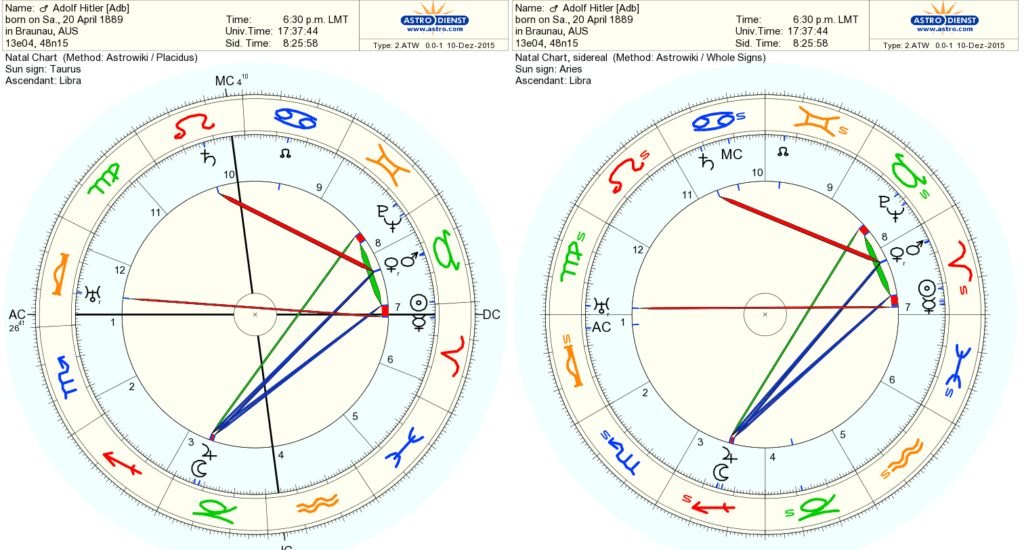
Figure 1 – Adolf Hitler

Figure 2 – Muhammad Ali
No doubt both Rudolf Steiner and Condaleeza Rice (Secretary of State and National Security Advisor to George W. Bush), owed much of their dynamism, confidence and force of character to the Ruchaka Yogas in their respective charts.
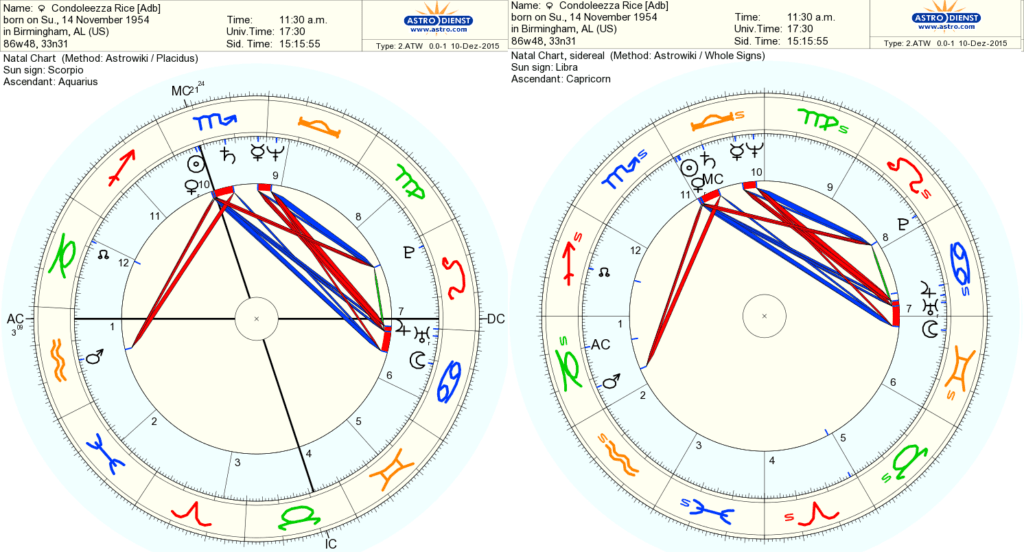
Figure 3 – Condoleeza Rice
Bhadra Yoga is the name for the Mahapurusha Yoga of Mercury, formed when Mercury is in Gemini or Virgo, while also occupying a ‘Kendra’ (angular house).
“The person born in Bhadra Yoga will be gifted with long life and keen intellect, will be clean, will be praised by the learned, will lead men, will be very rich, and will be clever in addressing an assembly.”
The Dalai Lama, known for his ready wit and youthful good humour, and a relentless teaching and speaking itinerary, was born with Bhadra Yoga (Mercury in Gemini in the 1st) in his Jyotish horoscope.
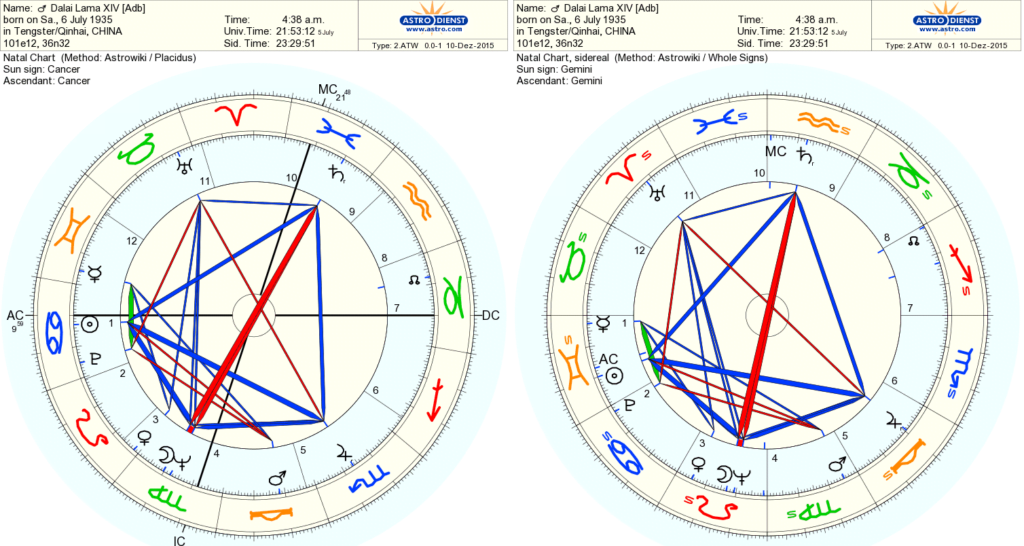
Figure 4 – The Dalai Lama
Bill Gates has it too (Mercury is exalted in Virgo, lord of asc, in the 4th). Along with the general Mercurial attributes of intelligence, ingenuity and knack for languages, ciphers and codes, the mercantile (earthy) and utilitarian aspect of Mercury is in his case conspicuous too. (4)
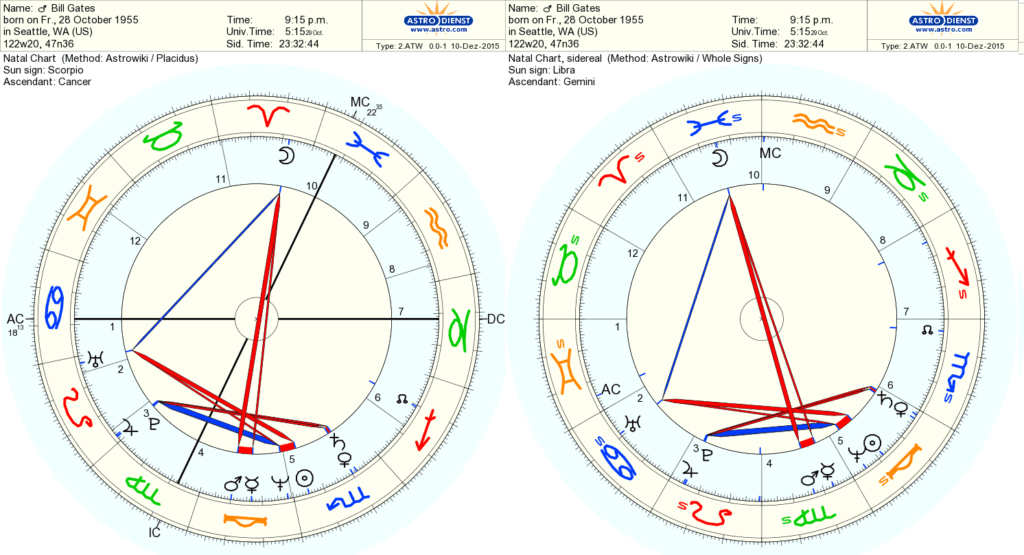
Figure 5 – Bill Gates
Hamsa Yoga is the Mahapurusha Yoga of Jupiter (Guru). It is formed when Jupiter is located in Sagittarius, Pisces or Cancer, while also being in an angular house (1, 4, 7, 10).
‘Hamsa’ means ‘goose’ or ‘swan’, and it is believed that the goose can separate (discriminate) between milk and water. A theme of spiritual discernment is implied. We know that Jupiter has holistic knowledge (is ‘endowed with all branches of learning’), and this can provide a breadth of perspective that makes accurate and balanced discernment possible. Naturally such a powerful Jupiter may make one a teacher of some kind, and indicates integrity and nobility of character.
“The person born in Hamsa Yoga will be a king extolled by the good… He will possess a beautiful body, will eat sumptuous food, and will be of a righteous disposition.”
The venerable Nicholas Culpeper, herbalist, physician and astrologer, was born under Hamsa Yoga. It’s quite a fine example of the power of such an extremely beneficial yoga has the to mitigate other less helpful factors, such as his debilitated Sidereal Sun, Mars and and Saturn. (5)
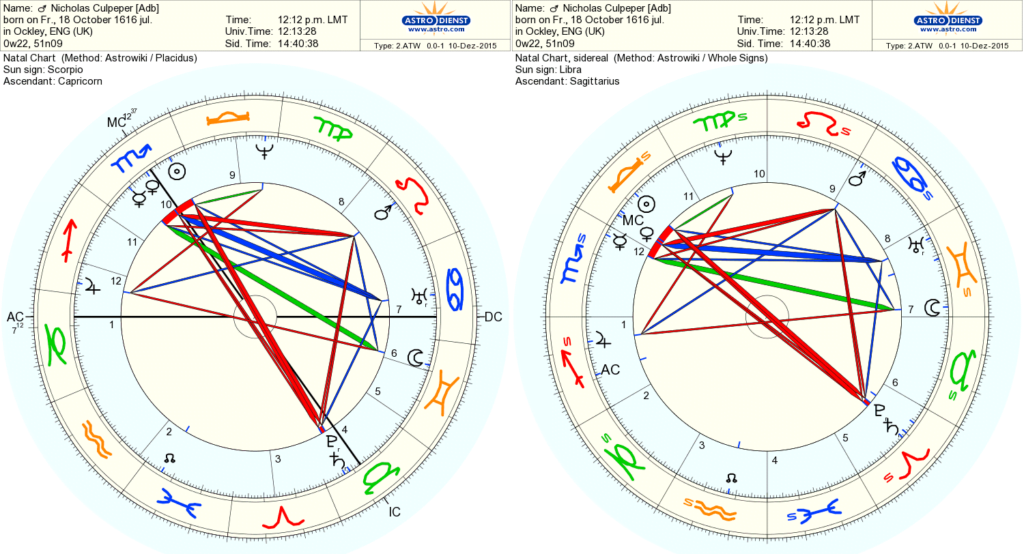
Figure 6 – Nicholas Culpeper
In Culpeper’s case the lord of the 1st is in the 1st which greatly safeguards his ‘name and fame’ and physical safety.
The mystical yet practical Rudolf Steiner had Jupiter in Cancer in the 10th. He emerged as the leading figure of the Theosophical movement in Europe around the time his Jupiter Dasha (16 year long major period of Jupiter) began.
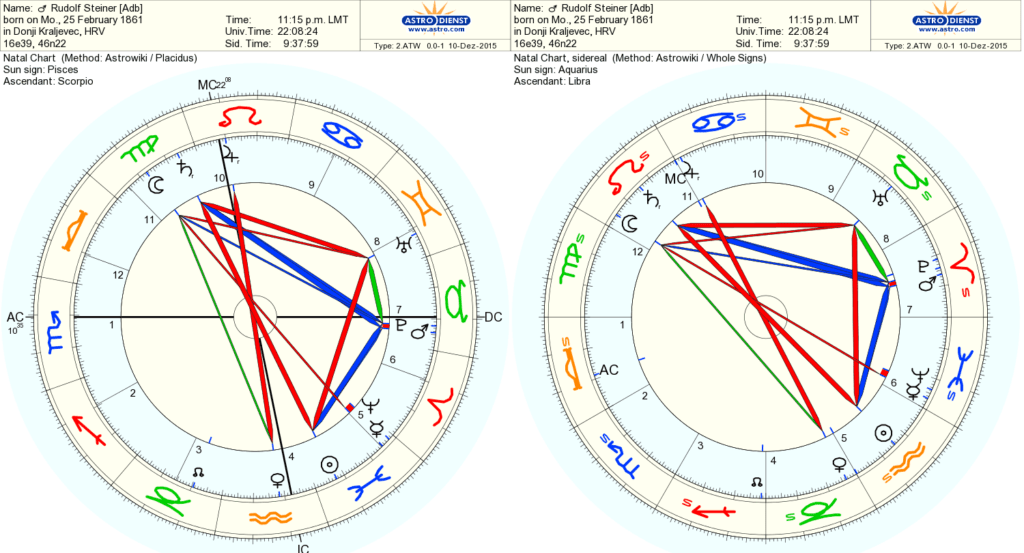
Figure 7 – Rudolf Steiner
Malavya Yoga is the Mahapurusha Yoga of Venus (Shukra). It is formed when Venus is located in Taurus, Libra or Pisces, while also being in an angular house (‘Kendra’).
“The person born in Malavya Yoga will have strong limbs, will be resolute, wealthy and endowed with wife, children and good fortune, will be prosperous, will eat good food, enjoy pleasures and command good vehicles, and will become famous and learned. He will possess unperturbed senses.”
Good looking David Beckam’s Jyotish chart contains Malavya Yoga (Venus in Taurus in the 1st House). He’s conspicuously ‘endowed with wife and child‘, and he is as famous for his Venusian virtues and life narrative as his athletic prowess (that seems amply accounted for by nimble Mercury on his Ascendant and Mars in the 10th).
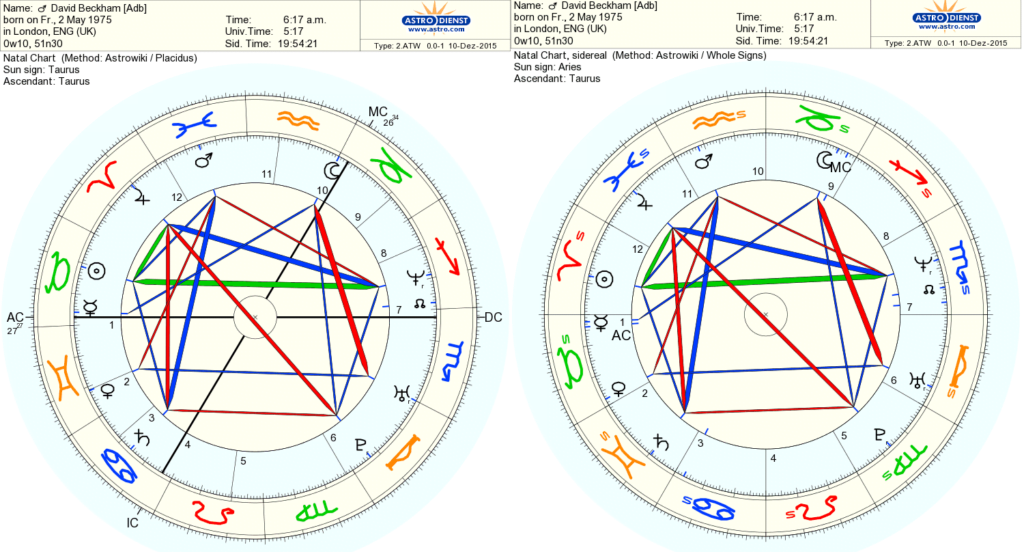
Figure 8 – David Beckham
Shasha Yoga is the Mahapurusha Yoga of Saturn. It is formed when Saturn is in Capricorn, Aquarius or Libra while also being located in a Kendra (angular house).
“The person born in Shasha Yoga will be extolled by all, will have good servants, will be strong, will be a king or the headman of a village, will be wicked in disposition, will have intrigues with women not his own, will usurp others’ wealth, and will be happy.”
Barack Obama qualifies for Shasha Yoga. Naturally an exceptionally empowered Saturn will help a political career.

Figure 9 – Barack Obama
See below Margaret Thatcher’s exalted Saturn in Sidereal Libra in the 1st House; an effective leader perhaps, but much reviled also.
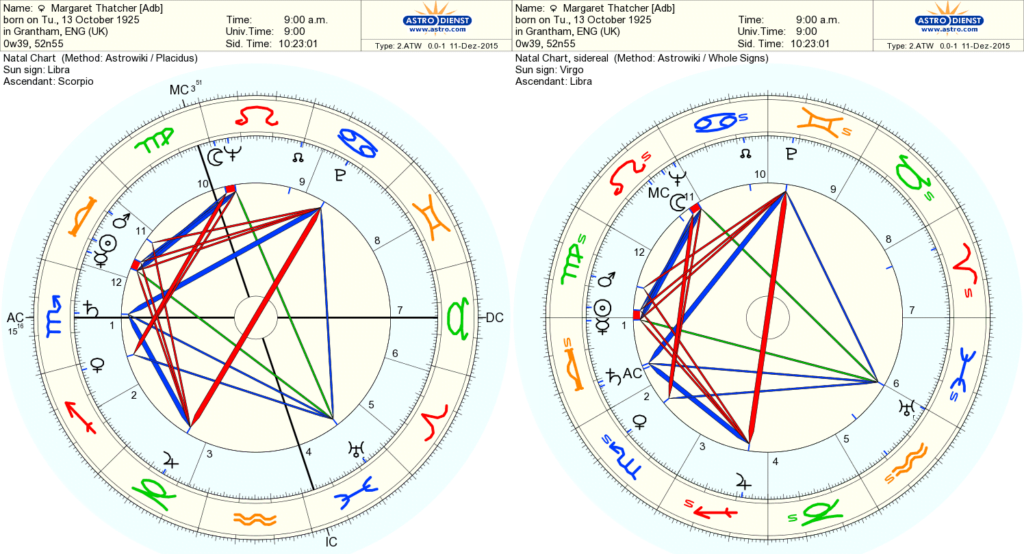
Figure 10 – Margaret Thatcher
Speaking of ‘wicked in disposition’, the notorious magician Aleister Crowley, dubbed the ‘wickedest man the world’ had such a potentized Saturn, regardless of which zodiac and house system you use, along with two other Mahapurusha Yogas in the Jyotish chart.
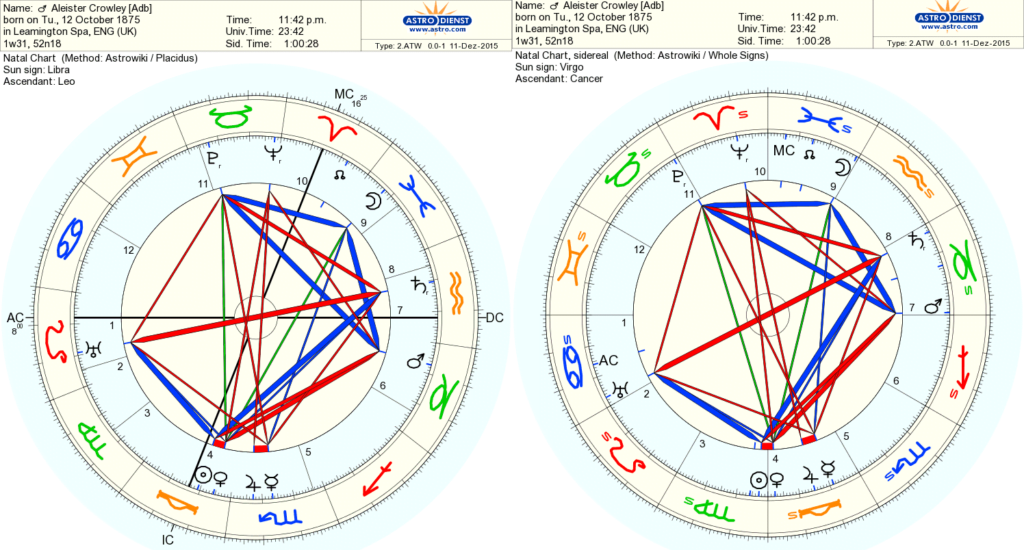
Figure 11 – Aleister Crowley
A quick note on Bhava Karakas. A necessary digression for a full appreciation of this discussion on the Mahapurusha Yogas.
‘Bhava’ is the word conventionally used in Indian astrology for an astrological ‘House’. ‘Karaka’ translates as ‘significator’. If a Bhava’s Karaka is strong, it bodes well for the Bhava or House.
The Karaka planet represents, or has an important bearing on, the themes associated with the house/s for which it acts as significator. A house may be well fortified in terms of the planets that occupy it, it’s lord’s location and condition, etc., but if that house’s significator is in very poor shape, the house will be somewhat undermined none the less.
Conversely, a house which may seem to be undermined by virtue of the nature of the occupying planets (containing malefics), or the location and condition of it’s lord (lord in inimical sign or house), or the aspects (from malefics) to the house and it’s lord, may yet gain some substantial redemption if that Bhava’s Karaka is very powerfully placed.
Although there are some slight variations in the scheme of these ‘House Significators’, the table below will give you a good idea of the most commonly accepted correspondences.
Bhava/House Karaka/Significator
1st House Sun
2nd House Mercury, Jupiter
3rd House Mars
4th House Moon, Venus (sometimes Mars)
5th House Jupiter
6th House Mars, Saturn
7th House Venus (Jupiter traditionally for women)
8th House Saturn
9th House Sun, Jupiter
10th House Sun, Mercury, Jupiter, Saturn
11th House Jupiter
12 House Saturn, Ketu
The point to note here is that the Mahapurusha Yogas not only alert us to the fact that a given planet is close to it’s maximum possible strength (in terms of sign and house placement), and therefore most likely a dominant force in the chart, a close reading of some of the above aphorisms from Phaladipika quoted above reveals that certain elements of the interpretations are not simply descriptions of the planetary symbolism or planetary types, the houses for which the planets act as permanent general significators (bhava karakas) inform the meaning of their ‘significator planet’s’ exalted status.
This is very explicit in such traditional statements as ‘will command good vehicles‘ for Malavya Yoga, the Mahapurusha Yoga of Venus. The 4th House of the horoscope in Jyotish represents cars, vehicles and conveyances (boats perhaps), over and above much of the other general significations for the 4th House shared with western astrology, such as the home, real estate, the mother (some western astrologers would agree, others not), and so on. It’s clear the aphorism, in it’s reference to ‘vehicles’, is doing so on the basis of the fact that Venus is a ‘Karaka’ or signficator for the 4th House of vehicles.
The charts below belong to a client of mine. The tropical western chart on the left, and on the right the Jyotish chart in something closer to it’s native format, showing the Dasha life cycle periods. Venus is here in Sidereal Pisces in the 10th House, and so his chart contains Malavya Yoga. Our first meeting occurred about a year after he had begun his 20 year long Venus Dasha (the major period of Venus, in which her role in the chart would blossom). In the course of breaking all the indicated good news to him, and on the basis of my experience of the accuracy of this link between cars, the 4th House and Venus, I said, “It says you will have good vehicles. You may always have had good vehicles, but the vehicles you will now have will be particularly good. It’s a silly little thing, but there’s something that’s awakened in you that will be reflected in high quality cars. Have you gotten a new car in the past year?”
He replied: “Just now. It’s a Porshe GT..(bla bla). Ordered it a year ago”.
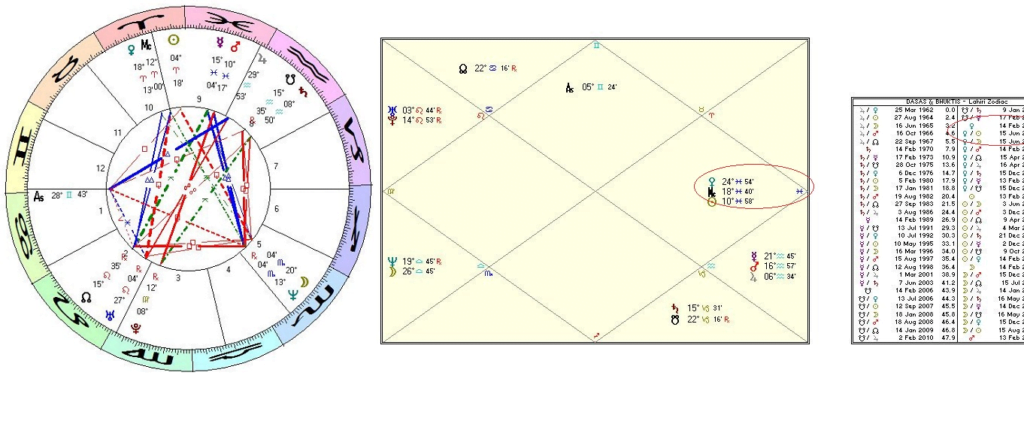
Figure 12
Going back to Phaladipika’s aphorism for Bhadra Yoga, the Mahapurusha Yoga of Mercury: the planet of eloquence, or at the least literacy (so essential to basic professional if not political success) is one of the Bhava Karakas for the 10th House of social status. This makes ‘will lead mean’ in Phaladipika’s interpretation for Bhadra Yoga more specifically meaningful and suggestive. Without command of Mercury, 10th House aspirations are missing an essential ingredient; yet with a very empowered Mercury on the other hand, 10th House potential abounds. A super-strong Mercury (being Karaka for the 2nd House also) may thus mean the native ‘will be very rich‘.
In Phaladipika’s aphorism for Shasha Yoga, the Mahapurusha Yoga of Saturn, we find ‘will have good servants‘ (6th House), ‘will usurp the wealth of others‘ (clearly 8th House), ‘will be wicked in disposition‘ (6th, 8th & 12th), ‘will have intrigues with women not his own‘ (the 12th House in Jyotish is associated with bed pleasures, not to speak of ‘intrigues‘ being covered well by 8th and 12th). An extremely powerful Saturn ‘enhances’ the houses for which it is a Bhava Karaka; the 6th, 8th and 12th.
Mata Hari’s chart contains Shasha Yoga (according to Light on Life’s broader definition of the formation of Mahapurusha Yogas, which includes the 5th and 9th Houses, over and above the Kendras), since Saturn is in Aquarius in the 5th House. This yoga recurs from her ‘Chandra Lagna’, or ‘Moon Ascendant’- a principle which will be expanded on below.
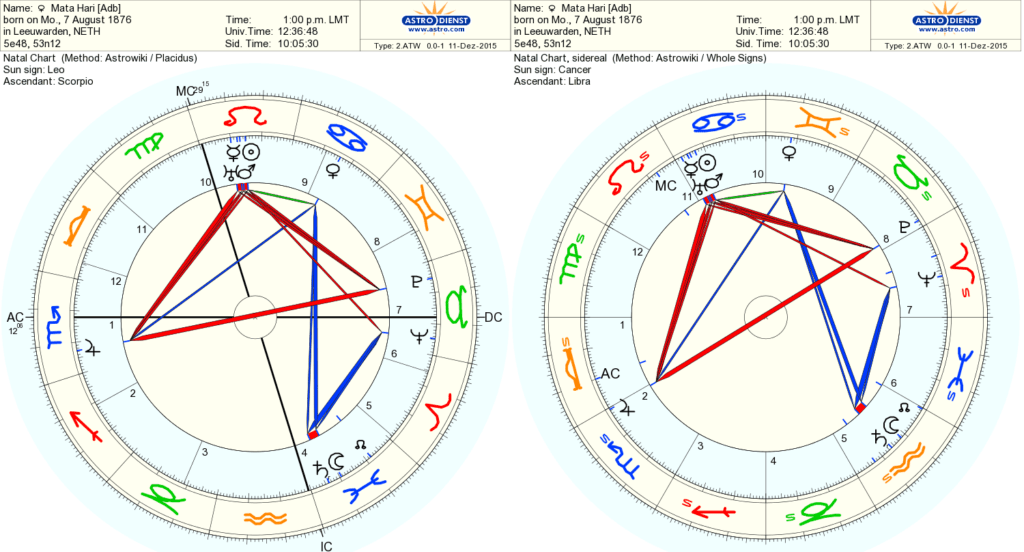
Figure 13 – Mata Hari
Needless to say many good people are born with Shasha Yoga in their charts. By Light on Life’s criteria that would include the Dalai Lama, who has Saturn in Aquarius in the 9th (lord of 9th in 9th preserves the 9th, even if it’s Saturn), but it always points to a certain prominent Saturnine streak which may, in it’s more exalted manifestation, show as constructive practicality in worldly matters, and even aptitude for politics (Saturn is a 10th House Karaka), where the need to navigate through a world of secrets, sins and intrigues (8th and 12th Karaka) is par for the course, even if you have the noblest intentions.
Raja Yogas
‘Raja’ means ‘king’. Raja Yogas are combinations for ‘kingly success’. There are many types of combinations that constitute a Raja Yoga of some grade or other.
I want to focus here on presenting a particular common approach to identifying Raja Yogas: the ‘Dharma Karma Adhipati Yogas’, or ‘combinations of the lords of fortune and action’. These occur through various relationships between Kendra (1st, 4th, 7th & 10th) and Kona (1st, 5th & 9th) lords. Combinations of the 9th and 10th lords are considered particularly powerful.
‘Karma’ means simply ‘action’ (no guilt implied). The Kendras or angular houses (1st, 4th, 7th & 10th) represent externalized manifestation and movement and are regarded as ‘karma houses’. Western astrology and Jyotish have in principle an identical view of the angular houses being the ‘foreground’ of the chart, where the energies of planets are most obviously active and exteriorized.
The 1st, 5th and 9th Houses, or ‘Konas’, the houses that correspond to the signs of the fire triplicity of the zodiac, are also known as ‘Dharma’ houses in Jyotish. Dharma can translate roughly as ‘authentic self-expression’, or sometimes as ‘life purpose’ in the context of the horoscope. These ‘fire houses’ represent, in a sense, where we are most inspired and most free and most true to our essential nature.
If you think of 1st House, it’s the very simple pure truth of who we are, as revealed in our face, and at our birth. The 5th House, the heart, the bosom, the house of romance and play, is in its ideal manifestation a peak state of joy and exhilaration, and a type of completely honest and pure self-expression. The 9th House is the ever expanding horizon of the ignited seeker, who transported thereby above and beyond limitations and gloom that oppress souls who cannot access this state. These Konas in Jyotish are considered distinctly auspicious.
If you can get this fiery grace and creative intelligence (Konas) to combine with ambition, action and manifestation (Kendras), you can become a ‘raja’, a ‘king’. A king is one whose worldly actions are mandated by dharma. When the action and dynamism of the Kendras is combined with the inspiration and integrity of Konas, you get an alchemical blend that produces ‘works aligned to authentic purpose’. Success (without error or sin due to misaligned intentions and motives) is the result.
In Richard Branson’s chart Moon is lord of the 1st House (a Kendra) in mutual aspect (due to being in opposite signs) to 9th lord Jupiter. So this is a Raja Yoga of a kind in his 2nd and 8th Houses. It could be added that Jupiter as 9th lord being in mutual aspect to 7th lord Saturn forms another Raja Yoga combination in the same 2nd/8th axis.
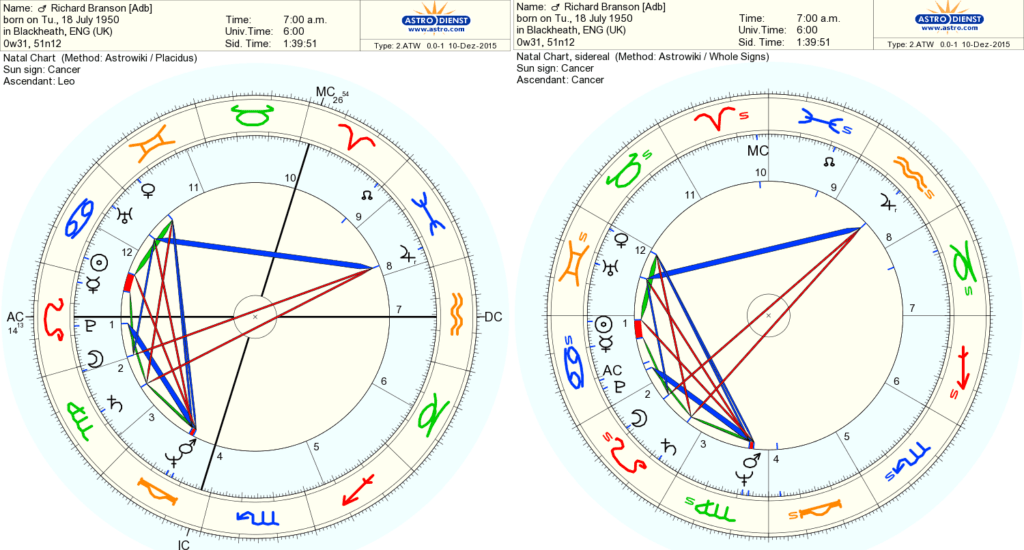
Figure 14 – Richard Branson
The Ascendant lord is always lord of both a Kendra and a Kona automatically, and in that lies much of it’s assumed benefic status for that Ascendant, even when it’s a natural malefic. The fact that it is both a Kendra and a Kona could be cited also as a reason for the 1st House’s pre-eminence among the Houses.
Some Ascendants (not all) have a planet, apart from the Ascendant lord, that is lord of one Kendra and one Kona. This is only possible for Taurus, Cancer, Leo, Libra, Capricorn and Aquarius Ascendants. This planet become known as the Raja Yoga Karaka (‘kingly combination significator’) for that particular Ascendant and becomes a powerful benefic regardless of it’s natural status as either benefic or malefic.
For the Taurus Ascendant, Capricorn being in the 9th and Aquarius in the 10th makes Saturn the Raja Yoga Karaka.
For the Cancer Ascendant, Scorpio in the 5th and Aries in the 10th makes Mars the Raja Yoga Karaka. (6)
For a Leo Ascendant, Scorpio in the 4th and Aries in the 9th makes Mars the Raja Yoga Karaka.
For the Libra Ascendant, Capricorn in the 4th and Aquarius in the 5th makes Saturn the Raja Yoga Karaka. (7)
For the Capricorn Ascendant, Taurus in the 5th and Libra in the 10th makes Venus the Raja Yoga Karaka.
For the Aquarius Ascendant, Taurus is in the 4th and Libra in the 9th making Venus the Raja Yoga Karaka.
Gaja Kesari Yoga
‘Gaja Kesari Yoga’ translates literally as ‘elephant lion combination’.
Here’s Parashara’s definition:
“Should Jupiter be in an angle from the Ascendant or from the Moon, and be conjunct or aspected by (another) benefic, avoiding at the same time debilitation, combustion and inimical sign, Gajakesari Yoga is caused. One born in Gajakesari Yoga will be splendorous, wealthy, intelligent, endowed with many laudable virtues and will please the king.”
Mohandas Gandhi’s chart (below) seems a good example of this yoga. Jupiter, in the sign of a friend, aspected by a strong Venus, is in a Kendra (angular house) from the Ascendant, being located in the 7th House, and also in the a Kendra from the Moon, being in the 10th House from the Moon (if the Moon’s constellation is taken as the 1st House).
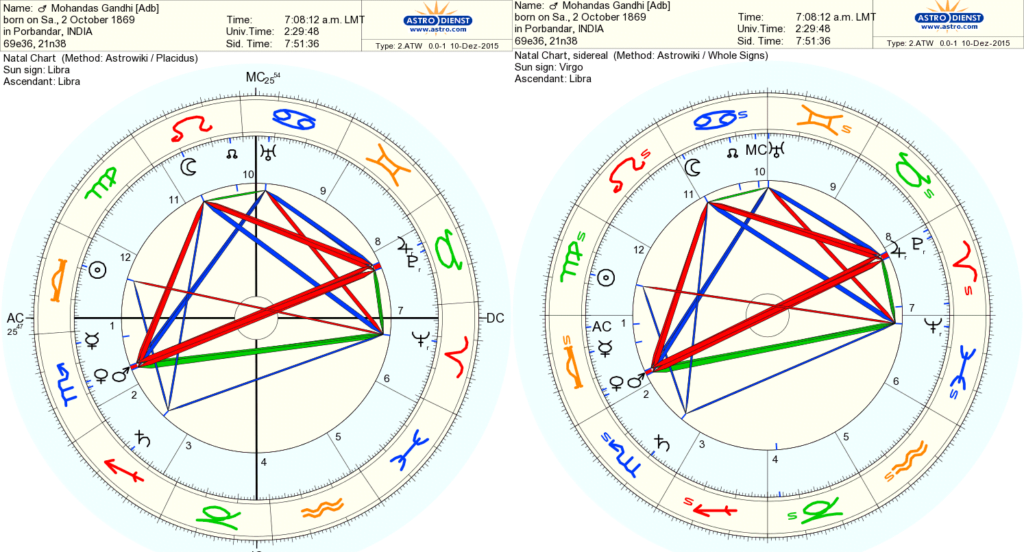
Figure 15 – Mohandas Gandhi
The ‘Chandra Lagna’, quite directly ‘Moon Ascendant’, is a chart in which houses are projected from the Moon sign as the originating point, as is normally done with the east horizon. Yogas that recur in the both the natal chart and the Chandra Lagna chart are thereby reinforced, as is the case with Mahatma Gandhi. Some yogas, such as Gajakesari Yoga, are specifically calculated from the Moon in addition to the regular Ascendant. Incidentally, transits (through houses) are regularly calculated from the Chandra Lagna.
All else being equal, Gajakesari Yoga will be formed when the Moon is in Square or Opposition aspect to Jupiter. Some western astrologers would give this configuration a negative interpretation due to the negative connotations associated with the Square and Opposition aspects. Through this yoga’s lens the ‘angularity’ of Jupiter is beneficial in that it brings the ‘laudable virtues’ of that planet to the fore. You present well, you ‘please the king’and become the preferred candidate.
Chandra Mangala Yoga
The name of this combination could be translated simply as ‘Moon Mars Union’. This yoga is formed when Moon and Mars occupy the same house. It is also widely considered to be present when the Moon and Mars are in opposite signs and houses, and thus in mutual aspect.
That it should be a signature for wealth in a chart may surprise some, but that is what this combination promises, according to Jyotish tradition. It is true that in some cases it may come with some form of negative aggression, fights in the family, along the lines western astrologers would expect from a hard aspect of Moon and Mars, but, it also seems to imply a certain streetwise self-assertiveness that enables you to compete effectively, and thereby succeed in business.
I know of one case where a person exhibited all the love of fitness and grooming associated with Chandra Mangala Yoga, and started a little weight loss clinic, but she could never get it off the ground and was always lamenting: her Moon Mars union was located in the 12th House, with all the typical associated defeatism. She showed the spark of Chandra Mangala Yoga’s entrepreneurial promise, but, as far as I could tell, was perpetually sabotaging herself.
It’s not however surprising to find this combination in chart of Bill Gates (in the more empowered angular 4th and 10th houses). It describes his competitive spirit, and his initiative, but there’s more than just Chandra Mangala Yoga showing wealth in his chart, as one would expect from someone whose name becomes synonymous with wealth. His chart contains other impressive combinations that can raise you above others, or give you extraordinary worldly power.
Parivartana Yoga
Parivartana Yoga is an ‘exchange of lords’ between two houses. It occurs when two planets occupy each other’s signs, as would occur between Moon in Pisces and Jupiter in Cancer, for example, or between Moon in Scorpio and Mars in Cancer. In western astrology this is known as ‘mutual reception’.
It is considered generally beneficial and ‘auspicious’, but the nature (malefic/benefic) and ‘dignity’ of the planets involved will be important to consider. The two examples given above would yield very different stories. Parivartana Yoga powerfully links two houses in the natal chart.
Note the Parivartana Yoga between the Sun and Moon in Richard Branson’s chart given above. Here the 1st and 2nd Houses are combined by mutual reception; the 1st lord is in the 2nd and the 2nd lord in the 1st, and both planets are well placed in each other’s signs.
See below the chart of Albert Einstein. Jupiter is in Aquarius and Saturn in Pisces; Jupiter is lord of the 10th located in the 9th, and Saturn is lord of the 9th, located in the 10th (this linking of the 9th and 10th in itself constitutes a type of Raja Yoga). Einstein, fittingly, was offered the Presidency of Israel, but declined.
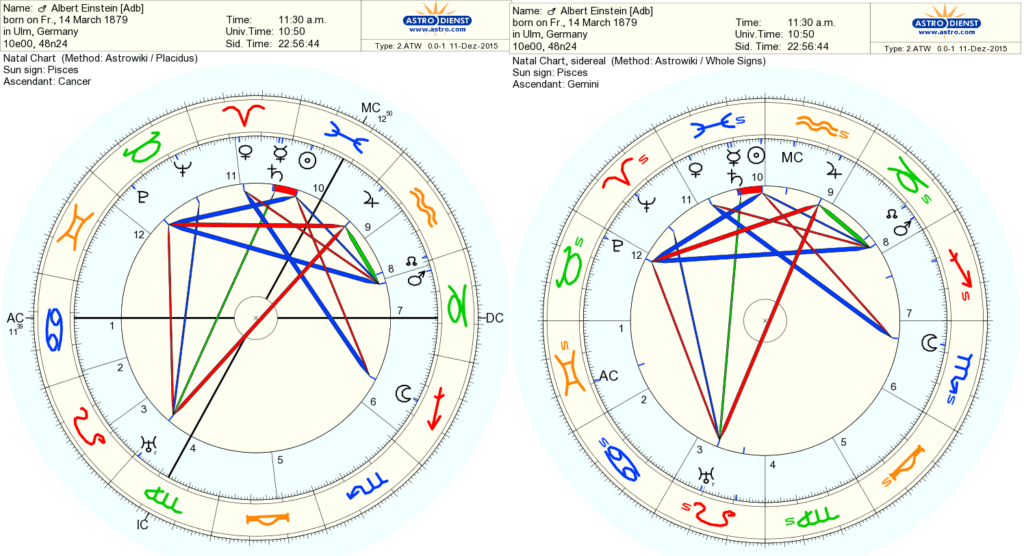
Figure 16 – Albert Einstein
As we will see below in the ‘Combinations for Penury’, Parivartana Yoga can at times simply point to a very powerful, but otherwise unfortunate entanglement between house lords. Parivartana Yoga or it’s more familiar term, Mutual Reception, is simply one of the most powerful ways planets and the houses for whom they act as lords can interact or exchange influence.
Saraswati Yoga
Saraswati is the Hindu goddess of music, learning and the arts. She is typically depicted holding a book, and a musical instrument. One with Saraswati Yoga in their natal chart can attain great heights in education, they can become extraordinarily erudite, they may excel in the arts and more or less any branch of learning they care to apply themselves to.

Saraswati Yoga is formed when Mercury, Venus and Jupiter are located in a Kendra (angular house), a Kona (a ‘trinal’ house- 1st, 5th, 9th), or the 2nd House. All the planets (Jupiter in particular) should be well placed by sign.
It is easy to believe and understand that for someone to be truly gifted in the arts and sciences they may require a number of faculties and skills to be well developed. When the three most refined and cultured planets are all in houses and signs that support their full and empowered expression, the composite result is this ‘blessing of Saraswati’.
The inclusion of the 2nd House in the criteria for this yoga’s formation is due to it’s association in Jyotish with education, learning, speech and memory.
In practice you will find several horoscopes in which the criteria for Saraswati Yoga are very nearly, but not completely, met. You will then find much of the potential for attainments in learning and the arts present in the person’s life or personality expression, but it would be easier to bring it into full bloom when all the criteria are not only met, but supported by further indications in the chart. Simply having a single one of the three planets involved in this yoga in a Kendra (angular house), Kona (‘trinal’ house), or in the 2nd House enhances intellectual, artistic, or academic potential to some degree.
Einstein’s chart qualifies, unsurprisingly, to a large extent for Saraswati Yoga; except for the debilitation of Mercury in the sign Pisces. This debilitation is however ‘cancelled’ by a ‘Neecha Bhanga Yoga’.
‘Neecha’ means debilitation and ‘Bhanga’ the breaking thereof. This breaking or cancelling of the debilitated status of a planet can occur in a number of ways. For one, the stronger the debilitated planet’s dispositor is, the better. If a debilitated planet’s dispositor is in an angular house, this cancels the debilitation. In Einstein’s case Mercury’s debilitation is cancelled by the fact that Venus, the planet that would be exalted in Mercury’s debilitation sign (Pisces), is in fact so powerfully placed in his chart.
Luciano Pavarotti has a well formed Saraswati Yoga in his chart (Venus in the 2nd, Mercury in the 4th, Jupiter strong by sign in the 5th). His Ascendant lord in the 9th House would no doubt have assisted him in finding his vocation.

Figure 17 – Luciano Pavarotti
Amala Yoga
In the words of Parashara:
“If there be exclusively a benefic in the 10th from the Ascendant or Moon, Amala Yoga exists. Amala Yoga will confer fame lasting as long as the moon and stars endure and will make the native honoured by the king, enjoy abundant pleasures, be charitable; fond of relatives, helpful to others, pious and virtuous”
‘Amala’ means ‘stainless’. The person enjoys a sterling reputation, since they do good works that benefit society and show goodwill to others in their public dealings.
The famous astrologer Robert Hand, who will no doubt be remembered and praised for his work long after he leaves this world, has Amala Yoga in his chart, counted from the Moon (and, incidentally, also Saraswati Yoga from the Moon). Jupiter’s exaltation greatly strengthens this yoga in his chart.

Figure 18 – Robert Hand
Dhana Yogas
Dhana Yogas are a specific group of yogas that promise great wealth. A close look at how they’re structured reveals certain important Jyotish principles regarding how wealth is more generally judged in the horoscope. The first thing to note is the pivotal role of the 11th House as the house of ‘gains’ and income. Although the second house is also associated with money and property in Jyotish, the 11th House is even more closely scrutinized in this matter.
A few examples will illustrate:
From Brihat Parashara Hora:
“Should a sign of Venus be in the 5th House and occupied by Venus himself while Mars is in the 11th House, the native will obtain great riches.”
Only Gemini and Capricorn Ascendants can have a Venus ruled sign in the 5th House. For this yoga to be formed Venus must be in the 5th, in either Libra or Taurus respectively, and thus in her own sign. This is a great boost for the 5th House and it’s lord. If Mars is in the 11th for a Gemini Ascendant it has to be in Aries, it’s own sign, so then the lord of the 11th is in the 11th; a great boost for the 11th. If Mars is in the 11th for a Capricorn Ascendant it will also be in it’s own sign.
If you refer back to Bill Gates’ chart, you’ll see he has something close to this Dhana Yoga, but not perfectly. His Ascendant is Gemini, Venus is in Libra in the 5th (with an exalted 9th lord Saturn), but his Mars (a key wealth significantor for the Gemini Asc as 11th lord) is in the angular 4th with it’s exalted dispositor, and not itself in the 11th as per the strict criteria for this yoga.
Here’s another Dhana Yoga structure according Parashara that applies only to the Aries Ascendant:
“Should Leo be 5th House and occupied by the Sun himself as Saturn, the Moon and Jupiter occupy the 11th, the native will be very affluent.”
Again here you have lord of the 5th in it’s own sign, and lord of the 11th in it’s own sign. Moon (lord of the angular 4th) and Jupiter (lord of the beneficent 9th) reinforce the benefit gained by the 11th House due to containing it’s own lord, and perhaps further serve to mitigate 11th lord Saturn’s essentially malefic nature.
For Leo and Scorpio Ascendants:
“Should Jupiter be in the 5th identical with his own sign as Mercury is in the 11th, the native will be very affluent.”
For a Leo Ascendant Jupiter needs to be in Sagittarius in the 5th House, and Mercury in the 11th in Gemini. For the Scorpio Ascendant Jupiter would be in Pisces in the 5th, with exalted Mercury in Virgo in the 11th.
Similar rules for wealth are applied to other Ascendants which would result in very well dignified 5th and 11th Houses.
Lakshmi Yoga
Lakshmi is the Hindu goddess of wealth and fortune. Many modern depictions of her show gold coins streaming from her palms.
Lakshmi Yoga is formed when lord of 9th House and Venus occupy their own or exalted signs while in Kendra (1st, 4th, 7th, 10th) or Kona (1st, 5th, 9th) Houses.
We noted earlier that Bill Gates has a nearly fully formed Dhana Yoga in his chart, thanks largely to his Venus in Libra in the 5th House (but failing on account of the position of Mars). His chart does however fully meet the criteria for Laksmi Yoga. Saturn, exalted lord of his 9th, is Conjunct Venus in her own sign as lord of the 5th in the 5th.
Combinations for Penury
Chapter 42 of the sage Parashara’s Brihat Parasara Hora Sastra, titled ‘Combinations for Penury’ opens thus:
“1. O Lord, you have stated many yogas related to acquisition of wealth. Please tell me such yogas causing utter poverty.
2. The native will be penniless if the Ascendant lord is in the 12th as the 12th lord is in the Ascendant along with a Maraka lord (death inflicting planet, the 2nd or 7th lord) or be in aspect to such a planet.
3. The native will be penniless if the Ascendant lord is in the 6th while the 6th lord is in the Ascendant with Conjunction or aspect of a Maraka lord.
4. Should the Ascendant or the Moon be with Ketu while the Ascendant lord is in the 8th, the person concerned will be penniless.
5. If the Ascendant lord along with a malefic is in the 6th, 8th or 12th while the 2nd lord is in an enemy’s sign or debilitated, even a royal scion will become penniless.
6. If the Ascendant lord is Conjunct an evil house lord (lord of 6th, 8th or 12th) or Saturn and be devoid of benefic aspect the native will be penniless.
7. Should the 5th and 9th lords be respectively found in the 6th and 12th and be in aspect to Maraka planets, the native will be penniless.”
It goes on to list several more combinations in like vein, some more complex than those listed above.
Kemadruma Yoga
When there is no planet (excluding the Sun) conjunct (in same sign as) the Moon, and no planet in the 2nd or 12th Houses from the Moon, and no planet in an angular house from the Ascendant (in the 1st, 4th, 7th or 10th); Kemadruma Yoga is formed.
According to B.V. Raman’s Three Hundred Important Combinations, Kemadruma Yoga indicates:
“The person will be dirty, sorrowful, doing unrighteous deeds, poor, dependent, a rogue and a swindler.”
Freedom Cole notes in his book Science of Light that Kemadruma Yoga is cancelled by ‘the Aspect of Jupiter’ (presumably to the Moon).
This criteria for this undesirable yoga combines at least two significant principles of Vedic astrology. One is that the familial Moon in particular is a planet that benefits from association and the proximity of other planets. Even malefics are better than nobody nearby at all. This yoga tends to produce a sense of alienation from others.
The other is the importance of planets in the angular houses in enabling us to carve a way for ourselves in life through the externalization and outward expression of our talents.
Shakata Yoga
The Moon in the 6th, 8th or 12th from Jupiter creates Shakata Yoga. ‘Shakata’ means ‘cart’. This yoga is said to cause the native’s fortunes to rise and fall like a cartwheel. B.V. Raman says ‘the native loses his fortune and may regain it’ and adds that while it may bring some periodic losses, it will not inevitably devastate your life.
This yoga is nullified if the Moon occupies a Kendra (angular house).
Perhaps Oscar Wilde owes some of the ups and downs in his fortunes to the Shakata Yoga in his chart (which is otherwise greatly bolstered by the powerful placements of Mars and Jupiter).
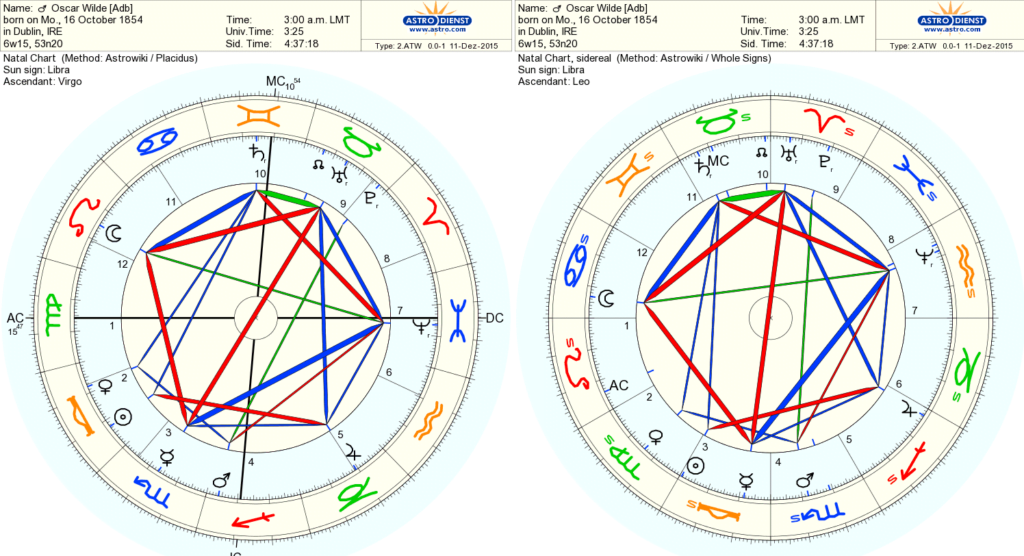
Figure 19 – Oscar Wilder
Kala Sarpa Yoga
‘Kala’ means time and ‘Sarpa’ means serpent. ‘Time Serpent Combination’ is therefor a close translation.
Kala Sarpa Yoga is formed when all seven planets (Sun to Saturn) are located between Rahu (North Node) and Ketu (South Node); in other words, all the planets of classical astrology on one side of the Nodal axis.
This is a rather peculiar and mysterious yoga. It is associated with dramatic life developments, or extraordinary life circumstances. There may be a meteoric rise and association with royalty and society’s elite, but also sudden and catastrophic reversals. There’s an element of unpredictability about it.
The controversial Donald Trump’s chart contains Kala Sarpa Yoga (8) and sure enough his career has been quite extraordinary, with dramatic successes and failures. Linda Johnsen notes that the yoga ‘was fully activated in Trump’s chart because he was born so near a lunar eclipse, the nodes palpably signalling their power’. (9)
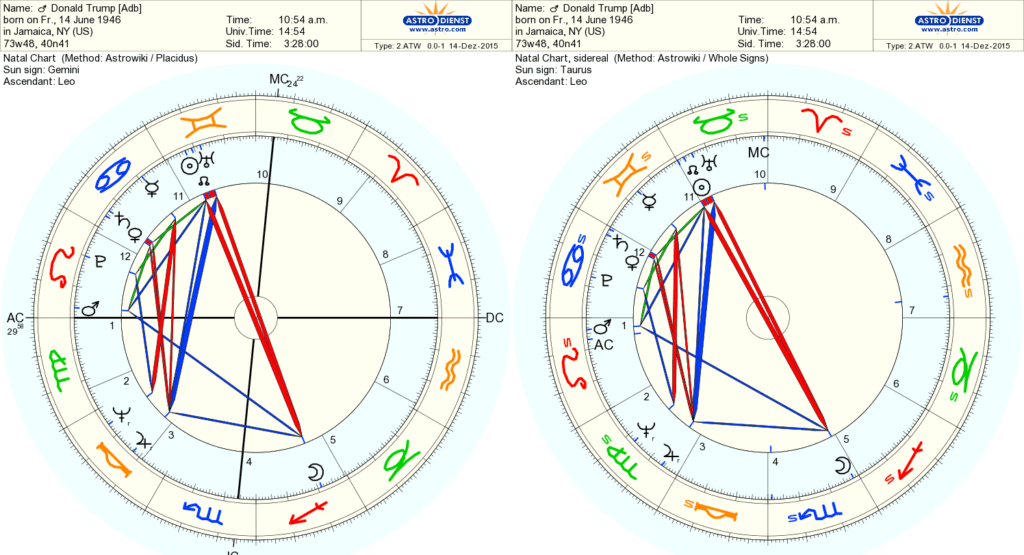
Figure 20 – Donald Trump
This article has attempted to give you some idea of how ‘Yogas’ are employed in Jyotish to identify and interpret astrological combinations with special significance. There are hundreds more of these yogas to investigate beyond this small sampling.
It is true that some of the old aphorisms of traditional Jyotish may in certain respects be outdated, or culturally ‘alien’ to westerners, but I believe only superficially so. ‘The more things change the more they stay the same’; it’s just as true that within Jyotisha’s ancient lore there are timeless techniques and principles we can still learn from today.
Notes:
(1) There’s more to learn about the various diagrammatical format and tabulation conventions of Jyotish, but it’s not essential for us to go into it here now. These basic adjustments of the ‘calculation settings’; the application of a Sidereal Zodiac and Whole Houses, will give the correct Jyotish sign and house placements. Bear in mind when converting charts in this way that if the Ascending degree of a Sidereal chart is close to the cusp of two signs, a small error in the time of birth could result in a dramatic change in the house placements of all the planets.
(2) Light on Life, an introduction to the Astrology of India, by Hart de Fouw and Robert Svoboda. Penguin Books, 1996.
(3) “Phaladeepika is a treatise on Hindu astrology written by Mantreswara. The text is written in lyrical Sanskrit verse comprises 865 slokas and 28 chapters. It is one of the more significant works on Hindu astrology, along with Bṛhat Parāśara Horāśāstra of Parashara, Brihat Jataka of Varahamihira, and Jataka Parijata of Vaidyanatha Dikshita. It deals in a most comprehensive and authoritative manner with almost all astrological aspects of human life.”
(4) There seems to be some doubt about the correct time of birth for Bill Gates. I have to date been working with the ‘shortly after 9:00pm’ chart as found in Solar Fire’s archive of famous charts. I notice that astro.com gives a chart for 10:00pm but acknowledges the other ‘shortly after 9:00pm’ possibility in the source notes.
(5) Nicholas Culpeper did indeed suffer his share of tragedy and frustration attributable to the debilitated planets in his chart. His mother died of breast cancer when he was young, and he himself was shot in the chest during military service. Note debilitated Mars in Sidereal Cancer also in the chart of Mata Hara, executed by gunshot.
(6) This Raja Yoga Karaka status of Mars for the Cancer Ascendant further enhanced the ‘fame and success making potential’ of Muhammed Ali’s Mars in the 10th.
(7) Hitler’s Saturn in the 10th was therefore more certain to raise him to a high position. It is a curious fact that Mohandas Gandhi wielded power and changed the course of large scale social events through extreme fasting, shown, it seems, in Saturn as Raja Yoga Karaka in his 2nd House.
(8) Solar Fire’s database of famous charts, and other sources, give his time of birth as 9:51am. This ambiguity is noted in the source notes of the astro.com astrodatabank entry on Donald Trump.
(9) Hindu Astrology Lessons- Richard Houck (editor), Groundswell Press, pg. 141.